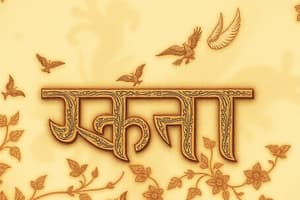Podcast
Questions and Answers
What type of script does Hindi use for writing?
What type of script does Hindi use for writing?
- Cyrillic script
- Arabic script
- Latin script
- Devanagari script (correct)
Which of the following is a major dialect of Hindi?
Which of the following is a major dialect of Hindi?
- Marathi
- Gujarati
- Khari Boli (correct)
- Bengali
What is the typical sentence structure in Hindi?
What is the typical sentence structure in Hindi?
- Subject-Object-Verb (correct)
- Object-Subject-Verb
- Verb-Subject-Object
- Subject-Verb-Object
What is one of the official statuses of Hindi?
What is one of the official statuses of Hindi?
Which authors are known for their contributions to Hindi literature?
Which authors are known for their contributions to Hindi literature?
Flashcards are hidden until you start studying
Study Notes
Overview of Hindi
- Language Family: Indo-Aryan, part of the Indo-European language family.
- Speakers: Over 500 million native speakers; widely spoken in India and parts of Nepal.
- Official Status: One of the official languages of India; also recognized in Fiji, Mauritius, and Suriname.
Script
- Writing System: Devanagari script, which is an abugida (each character represents a consonant with an inherent vowel).
- Characteristics:
- Contains 11 vowels and 33 consonants.
- Written from left to right.
Dialects
- Major Dialects:
- Khari Boli: Standard Hindi, used in education and media.
- Awadhi, Bhojpuri, Maithili: Regional dialects with distinct features.
Grammar
- Nouns: Gendered (masculine and feminine); pluralization is done differently based on gender.
- Verbs: Inflected for tense, aspect, mood, and subject.
- Sentence Structure: Typically follows Subject-Object-Verb (SOV) order.
Vocabulary
- Loanwords: Incorporates vocabulary from Persian, Arabic, English, and Sanskrit.
- Number of Words: Rich lexicon with a focus on both formal and colloquial expressions.
Cultural Significance
- Literature: A rich tradition including poetry, novels, and plays; prominent authors include Premchand and Faiz Ahmed Faiz.
- Media: Extensive use in films (Bollywood), television, and music, influencing popular culture.
Learning Resources
- Courses: Available through language institutes, online platforms, and universities.
- Materials: Textbooks, online dictionaries, language apps, podcasts, and films.
Dialects and Regional Variations
- Variations exist in pronunciation, vocabulary, and syntax based on geographic regions.
- Influence from local languages like Punjabi, Gujarati, and Bengali.
Modern Usage
- Global Presence: Increasingly popular as a second language worldwide.
- Digital Communication: Widely used on social media, messaging platforms, and in technological applications.
Overview of Hindi
- Language Family: Hindi belongs to the Indo-Aryan group within the larger Indo-European family, showcasing a rich linguistic heritage.
- Speakers: More than 500 million native speakers, primarily in India, with significant presence in Nepal.
- Official Status: Hindi is one of India’s official languages and enjoys recognition in countries like Fiji, Mauritius, and Suriname.
Script
- Writing System: Utilizes the Devanagari script, characterized as an abugida where each character represents a consonant combined with an inherent vowel.
- Characteristics: The script includes 11 vowels and 33 consonants and is written from left to right.
Dialects
- Major Dialects:
- Khari Boli serves as the standard form of Hindi, commonly used in educational and media settings.
- Regional dialects such as Awadhi, Bhojpuri, and Maithili possess unique linguistic features.
Grammar
- Nouns: Hindi nouns are gendered (masculine and feminine), with pluralization varying according to gender.
- Verbs: Verbs are inflected based on tense, aspect, mood, and subject, adding complexity to sentence construction.
- Sentence Structure: Predominantly follows a Subject-Object-Verb (SOV) order, distinguishing it from English syntax.
Vocabulary
- Loanwords: The vocabulary incorporates numerous loanwords from Persian, Arabic, English, and Sanskrit, enriching its lexicon.
- Number of Words: Exhibits a diverse range of expressions, encompassing both formal and colloquial language.
Cultural Significance
- Literature: Hindi features a vibrant literary tradition, encompassing poetry, novels, and plays, with notable authors such as Premchand and Faiz Ahmed Faiz.
- Media: Hindi plays a crucial role in Bollywood films, television, and music, significantly impacting popular culture.
Learning Resources
- Courses: Hindi language courses are offered by various institutes, online platforms, and universities, catering to different learning preferences.
- Materials: Resources include textbooks, online dictionaries, language apps, podcasts, and films, facilitating a comprehensive learning experience.
Dialects and Regional Variations
- Pronunciation, vocabulary, and syntax vary significantly across regions, influenced by surrounding local languages such as Punjabi, Gujarati, and Bengali.
Modern Usage
- Global Presence: Hindi is becoming increasingly popular as a second language on a worldwide scale, appealing to learners of diverse backgrounds.
- Digital Communication: Hindi is actively used on social media and messaging platforms, reflecting its relevance in modern communication contexts.
Studying That Suits You
Use AI to generate personalized quizzes and flashcards to suit your learning preferences.




